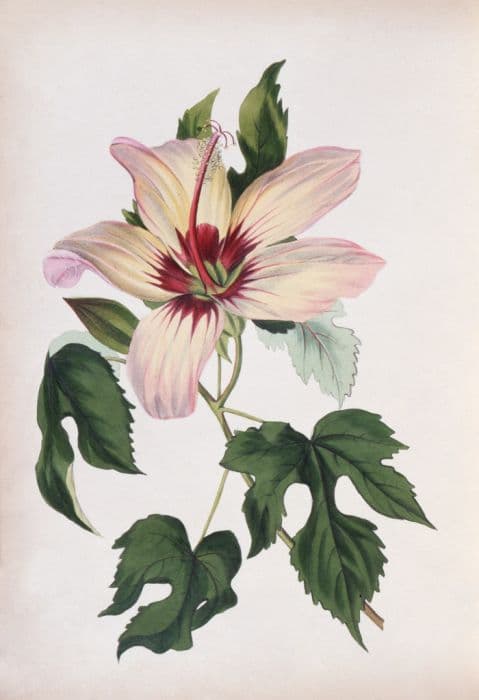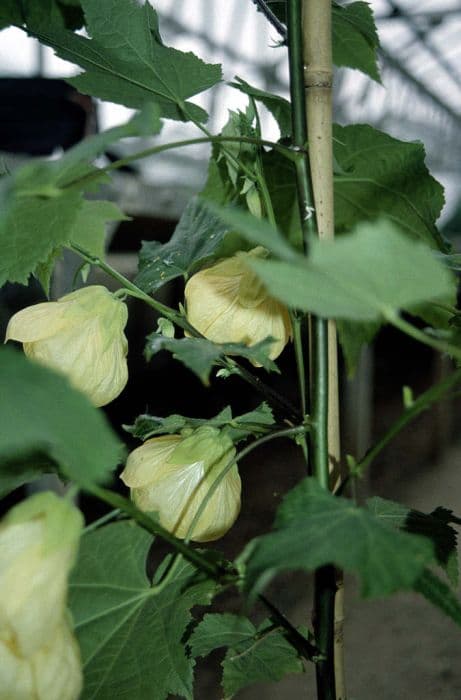Chinese hibiscus Hibiscus rosa-sinensis

ABOUT
Hibiscus rosa-sinensis, commonly known as hibiscus or Chinese hibiscus, is a vibrant and showy plant prized for its large, trumpet-shaped flowers that exhibit a wide range of colors, including shades of red, pink, orange, yellow, and white. Often featuring a contrasting colored center, the flowers typically have five or more wide, overlapping petals that can appear both ruffled and smooth. The blossoms can be either single, with a single layer of petals, or double, with multiple layers. The leaves of the hibiscus are glossy, dark green, and have a leathery texture with a toothed or slightly lobed edge. They are alternate, ovate to lanceolate in shape, and usually have a pronounced tip. The plant tends to produce dense, lush foliage that serves as a vibrant backdrop to the striking flowers. Its branches are woody and brown, often creating a bushy and well-structured appearance. The overall shape of the hibiscus can range from a sprawling shrub to a more vertical, tree-like form, depending on how it is pruned and cared for. The stem and branches might also have some light, peeling bark which adds to the texture of the plant. In appropriate climates, this plant may bloom throughout the year, adding continuous color and visual interest to gardens. The blooms typically open in the early morning and begin to wilt by the afternoon of the next day; each flower lasts only a couple of days. The hibiscus not only adds aesthetic beauty to a garden setting but also attracts pollinators such as hummingbirds and butterflies, bringing even more life to its surroundings.
About this plant
 Names
NamesFamily
Malvaceae.
Synonyms
Chinese Hibiscus, China Rose, Hawaiian Hibiscus, Rose Mallow, Shoeblack Plant.
Common names
Hibiscus boryanus, Hibiscus cooperi, Hibiscus festalis, Hibiscus genevii, Hibiscus immaculatus, Hibiscus liliiflorus, Hibiscus pacificus, Hibiscus platanifolius, Hibiscus pyrrhantus, Hibiscus storckii, Hibiscus teikii, Hibiscus rosa-sinensis var. festalis, Hibiscus rosa-sinensis var. immaculatus, Hibiscus rosa-sinensis var. platanifolius, Hibiscus rosa-sinensis var. rubroplenus.
 Toxicity
ToxicityTo humans
Hibiscus, specifically Hibiscus rosa-sinensis, is not known to be toxic to humans. There are generally no adverse effects associated with ingesting parts of this plant. In fact, some cultures use hibiscus flowers in teas and edible dishes. However, as with any plant, individual allergies or reactions can occur, so it is always advisable to exercise caution and consult a healthcare provider before consuming plants not commonly used as food.
To pets
In relation to pets, the hibiscus plant, including Hibiscus rosa-sinensis, is considered to be of low toxicity. If ingested in large enough quantities by pets, it could potentially cause mild gastrointestinal upset such as vomiting or diarrhea. Generally, ingestion of this plant is not expected to lead to serious poisoning or long-term health consequences for pets such as cats and dogs. Nevertheless, observing your pet for any unusual symptoms after ingestion and contacting a veterinarian for advice is always recommended.
 Characteristics
CharacteristicsLife cycle
Perennials
Foliage type
Evergreen
Color of leaves
Green
Flower color
Varies
Height
5-10 feet (1.5-3 meters)
Spread
5-10 feet (1.5-3 meters)
Plant type
Shrub
Hardiness zones
9
Native area
Asia
Benefits
 General Benefits
General Benefits- Ornamental Value: Hibiscus rosa-sinensis, commonly known as Chinese hibiscus, has large, colorful flowers that enhance the aesthetic appeal of gardens and landscapes.
- Shade Provider: The plant can grow into a sizeable bush or even a small tree, offering shade in gardens and outdoor spaces.
- Habitat for Wildlife: It attracts pollinators such as butterflies and bees, contributing to the health of the local ecosystem.
- Privacy Screen: When planted in a row or a hedge, it can provide a natural privacy screen for outdoor areas.
- Cultural Symbolism: Often associated with tropical locations, the Chinese hibiscus is a symbol of beauty and is used in many cultural events and ceremonies.
 Medical Properties
Medical Properties- Antioxidant: Hibiscus rosa-sinensis contains compounds that may help in reducing oxidative stress in the body.
- Anti-inflammatory: The plant has been used traditionally to reduce inflammation and may help in treating conditions associated with inflammation.
- Menstrual pain relief: Some cultures use Hibiscus rosa-sinensis to alleviate menstrual cramps and discomfort.
- Antibacterial: Extracts of Hibiscus rosa-sinensis have shown antibacterial properties against certain strains of bacteria.
- Wound healing: The mucilage and other compounds found in the plant may aid in the healing of wounds when applied topically.
- Hair care: While not a medical property, Hibiscus rosa-sinensis is often used in hair conditioners and treatments for promoting healthy hair.
 Air-purifying Qualities
Air-purifying QualitiesThis plant is not specifically known for air purifying qualities.
 Other Uses
Other Uses- Hair care: Hibiscus rosa-sinensis petals are used in shampoos and conditioners and can help to nourish and strengthen the hair.
- Shoe polish: The flowers can be used to make a natural, dye-based shoe polish that can enhance the color of leather goods.
- Natural dye: Hibiscus flowers can be used to make a natural dye for fabrics, papers, or crafts, imparting a range of pink to purple hues.
- Paper making: Hibiscus fibers can be incorporated into the paper-making process to add strength and texture to the finished product.
- Edible garnish: The vibrant blooms of the hibiscus can be used as an edible garnish in salads or on desserts for a splash of color.
- Rituals and offerings: In some cultures, Hibiscus rosa-sinensis flowers are used in religious ceremonies and offerings to deities.
- Art supplies: The petals and sap of the hibiscus can be used to make botanical paints and inks for artists.
- Livestock feed: In some regions, the leaves of the hibiscus plant are used as a supplementary feed for livestock due to their nutritional content.
- Leather tanning: The bark and roots of the hibiscus may sometimes be used in tanning leather, lending a reddish tinge to the material.
- Cooking extract: Hibiscus petals can be steeped in alcohol to create a flavorful extract used as a food flavoring or in cocktail mixology.
Interesting Facts
 Feng Shui
Feng ShuiThe Hibiscus is not used in Feng Shui practice.
 Zodiac Sign Compitability
Zodiac Sign CompitabilityThe Hibiscus is not used in astrology practice.
 Plant Symbolism
Plant Symbolism- Delicate beauty: The hibiscus flower is often associated with delicate beauty, owing to its large, colorful, and fragile blossoms.
- Femininity: Given its vibrant petals and soft shapes, the hibiscus can represent femininity and the beauty of women.
- Love: In many cultures, the hibiscus flower symbolizes love and passion, making it a popular choice in romantic contexts.
- Hospitality: Particularly in Hawaii, the hibiscus is a symbol of hospitality and is often worn by women to signify their welcoming nature.
- Wealth: Some interpretations consider the hibiscus to be a symbol of wealth due to its lush and full-bodied appearance.
- Fame: The hibiscus can also symbolize fame or celebrity, potentially stemming from its showy appearance and widespread cultivation in tropical and subtropical regions.
 Water
WaterThe Chinese hibiscus should be watered thoroughly, allowing the water to penetrate deep into the soil; however, the soil should be allowed to dry slightly between waterings. Generally, watering once a week is sufficient, but this can vary depending on temperature and humidity; in hot, dry conditions, more frequent watering may be necessary. Use approximately 1 gallon of water for outdoor plants and less for indoor potted hibiscus, adjusting based on the plant's size and the weather. It's important to avoid waterlogging, as Chinese hibiscus does not tolerate standing water well. During winter months or cooler weather, reduce watering to prevent root rot.
 Light
LightChinese hibiscus thrives best in bright, indirect sunlight, so placing it near a south or east-facing window is ideal. However, it can also tolerate some direct sunlight, particularly in the morning. Be cautious of too much harsh afternoon sunlight, which can scorch the leaves. For outdoor plants, choose a spot where they can receive at least a few hours of direct sunlight, but are protected during the hottest part of the day.
 Temperature
TemperatureChinese hibiscus prefers warm temperatures, thriving ideally between 60°F and 90°F. It can survive minimum temperatures of about 50°F but should be protected from frost, which can be harmful. The plant's growth may slow or become dormant if exposed to temperatures below or above this range for extended periods.
 Pruning
PruningChinese hibiscus requires pruning to shape the plant, encourage bushier growth, and remove any dead or diseased branches. The best time to prune is early spring, before new growth begins. Pruning can be done annually or as needed throughout the year to maintain a tidy appearance and promote healthy growth. Make sure to use clean, sharp pruning tools to make precise cuts.
 Cleaning
CleaningAs needed
 Soil
SoilFor a Hibiscus, the ideal soil mix should be well-draining and fertile, with good organic content. A mix consisting of two parts peat or coco coir, two parts perlite, and one part compost works well. The pH should be slightly acidic to neutral, ranging from 6.0 to 7.0.
 Repotting
RepottingA Hibiscus should be repotted every 1-2 years or when it outgrows its current pot. Repotting is best done in the spring or early summer.
 Humidity & Misting
Humidity & MistingHibiscus plants thrive in higher humidity levels, preferably between 50% and 70%. Maintaining adequate humidity can help ensure lush growth and prolific blooming.
 Suitable locations
Suitable locationsIndoor
Place in bright, indirect light, protect from drafts, and maintain humidity.
Outdoor
Provide full sun, shelter from strong winds, and mulch to retain moisture.
Hardiness zone
9-11 USDA
 Life cycle
Life cycleThe Chinese hibiscus, or Hibiscus rosa-sinensis, begins its life cycle as a seed, which germinates in warm, moist soil within a few days to several weeks. Once sprouted, the seedling grows rapidly in appropriate conditions of sunlight and moisture, developing into a young plant with characteristic glossy leaves and an upright form. As the plant matures, it develops the ability to flower, typically producing large, showy blooms that vary in color depending on the cultivar. After flowering, pollination can occur, potentially with the assistance of insects or birds, leading to the formation of seed pods that, when mature, release seeds for the next generation. Throughout its life, the hibiscus will go through cycles of growth, flowering, and dormancy, with flowering being most prolific in the warmer months. Proper care, including regular watering, feeding, and pruning, can extend the life of a Chinese hibiscus for many years, making it a long-lived perennial in tropical and subtropical climates.
 Propogation
PropogationPropogation time
Spring-Early Summer
For the hibiscus, also known as the Chinese hibiscus, one of the most popular methods of propagation is through softwood cuttings. This typically occurs in late spring or early summer when the plant's new growth is just beginning to mature. To propagate using this method, a gardener would cut a piece of stem about 4 to 6 inches long, strip the lower leaves, and dip the cut end into a rooting hormone. This prepared cutting is then placed into a pot filled with a mix of peat and perlite or sand to encourage drainage and aeration. The pot should be kept in a warm location with indirect light and covered with a plastic bag to maintain humidity. Roots usually develop within a few weeks, after which the new hibiscus plant can slowly acclimate to less humid conditions before eventually being planted in a permanent location outdoors.









